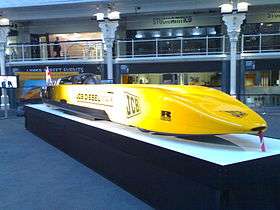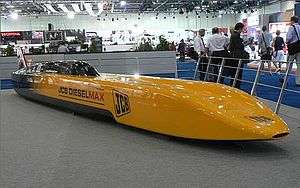JCB Dieselmax
| JCB Dieselmax | |
|---|---|
 | |
| Overview | |
| Manufacturer | Visioneering |
| Body and chassis | |
| Class | Land speed record vehicle (diesel) |
| Body style | Long |
| Layout | Dual-engine, 4-wheel drive |
| Platform | Hybrid square steel tube spaceframe with bonded carbon composite panels |
| Powertrain | |
| Engine | Two JCB444 common rail injection diesel engines with twin compound turbochargers and intercoolers |
| Transmission | Forward transmission and final drive connected to forward engine; rear transmission and final drive unit connected to rear engine |
| Dimensions | |
| Wheelbase | 5.9 m |
| Length | 9.1 m |
| Width | 1.15 m |
| Height | 0.98 m to canopy; 1.34 m to fin tip |
| Curb weight | 2.7 tonnes |

The JCB Dieselmax is a diesel-engined 'streamliner' car designed for the purpose of breaking the land speed record for a diesel-engined vehicle.
The car was built for JCB, a British multinational equipment company. As of 2014, the car holds the world diesel-powered land speed record, having been driven to over 350 miles per hour (560 km/h) by Wing Commander Andy Green in 2006.
Design
The car is powered by two specially-tuned versions of the production JCB444[1] powerplant, developing up to 750 brake horsepower (560 kW) each (over five times the power output of the production version with 90psi (6bar) of boost) and featuring four cylinders and 5 litres of displacement, accompanied by two stage turbochargers, intercooler and aftercooler. One of the dual engines drives the front wheels while the other drives the rear.[1] Each engine is rev-limited to 3800 rpm.
As the size of the car prohibited meaningful wind tunnel testing, the streamlined shape of the car was refined entirely through the use of computational fluid dynamics by MIRA Ltd, which has enabled the car to obtain a very low coefficient of drag of only 0.147 and a CdA value (drag coefficient × frontal area) of only 0.129 m². The fuel tank, which holds only 9 litres (2.38 U.S. gallons), is located directly behind the carbon fiber cockpit. The fully laden weight of the vehicle, including fuel, oil, ice, water coolant and the driver, is slightly less than 2,700 kg.
The chassis was designed and built by Coventry-based engineering company Visioneering for JCB, with engine development undertaken by Sussex-based Ricardo UK Ltd. The electrical system for the vehicle was supplied by R&D Vehicle Systems Ltd under contract to Visioneering.
During the 2006 Bonneville Speed Week and subsequent FIA record runs, the car was driven by Andy Green, a serving RAF Officer who previously broke, and still holds, the absolute land speed record with ThrustSSC.
Performance
600 brake horsepower (450 kW) version of the JCB444 engine, the team slowly ramping up the speed to prove the chassis and engines. They eventually achieved a speed of over 200 miles per hour (320 km/h) on 30 July 2006. Two days later, the car was disassembled ready to be flown to Wendover Airport, Utah, former home of the B-29 Enola Gay on 8 August. On 13 August 2006, after several days spent re-assembling and re-testing the car, the Dieselmax made its first official run on the Bonneville Salt Flats as part of Speed Week, eventually attaining an average speed of 317 miles per hour (510 km/h) to take the SCTA-BNI event record for an 'AA/DS' Diesel Streamliner.
On 22 August 2006, after being re-fitted with 750 brake horsepower (560 kW) 'LSR' versions of the JCB444 engines,[1] the JCB Dieselmax car broke the official FIA diesel engine land speed record, attaining a speed of 328.767 mph (529 km/h). 24 hours later the JCB Dieselmax car broke its own record, achieving a speed of 350.092 mph (563.418 km/h) over a distance of 1 mile[1] on 23 August 2006.[2] Before attaining these speeds, the Dieselmax was pushed from behind, by a JCB Fastrac, until it hit 30 miles per hour (48 km/h) where it engaged first gear.[1] Before the JCB Dieselmax records, the diesel land speed record was 235.756 mph (380 km/h), set by American Virgil Snyder, in the Thermo King streamliner on 25 August 1973.[3]
Future
In a live interview from Utah on BBC News, Green said that the car was not running at its full potential, due to problems finding suitable tires and that this speed was achieved while the car was still in fifth gear (the car has six). He also reported that the vehicle traveled 11 miles (18 km) on about a U.S. gallon (3.8 L) of fuel. The fuel tank holds just 9 L while the ice tank, used for cooling, holds 180 L.
Although JCB have not made any official statements on the subject of a return to Bonneville, JCB Group Engineering Director Tim Leverton has hinted that they are currently studying the development of tires that would allow them to overcome the nominal 350 miles per hour (560 km/h) 'safety limit' they had placed upon their current Goodyear units.
See also
References
- 1 2 3 4 5 Masamitsu, Emily, "Diesel Refined", Populember 2006: 23, ISSN 0032-4558
- ↑ "JCB car breaks own speed record", BBC News, 2006-08-23, retrieved 2013-10-16
- ↑ Shelley, Tom (2006-06-20), "Diesel goes for record", Eureka, retrieved 2013-10-16
External links
- BBC News, Dieselmax breaks diesel speed record
- The engineering behind Dieselmax, Ingenia Magazine, September 2007
- RDVS - Dieselmax electrical system supplier